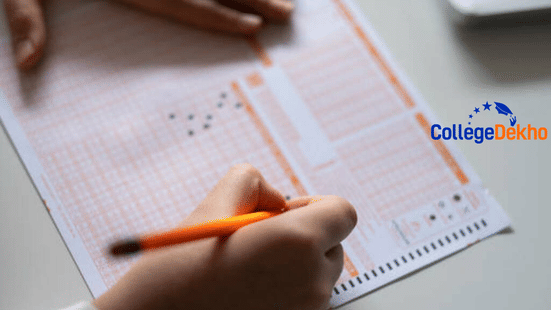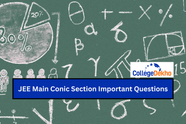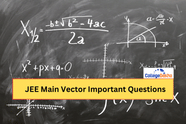
The JEE Main 2026 exam is an important milestone for those looking to take admission into the best engineering colleges in India. The exam is based on the NCERT curriculum standards for Classes 11 and 12. As the competition becomes increasingly challenging every year, it is essential for you to be aware of the difficulty level of the examination papers set by the National Testing Agency. NTA JEE Main paper difficulty level impacts your preparation. The conducting body provides a fair, consistent and well-balanced examination process ensuring each of you get an equal opportunity to score in the exam. Once you figure out how NTA decides these things, you can prepare much better for the types of questions that you may get in the JEE Mains 2026 exam. This article explains to you how the NTA determines the difficulty level of the JEE Main exam with a focus on the topic-wise distribution for 2026.
Also Check -
JEE Main 2026: List of Chapters & Topics Covered Under Chemistry Section
NTA's Approach for JEE Main 2026
The National Testing Agency (NTA) is a well-structured organization whose main role is to properly conduct the national-level JEE Main exam. It is also responsible for determining the difficulty level of the exam, and make sure that every student gets a fair, equal and balanced opportunity. For that, NTA analyzes the previous years’ papers, discusses with subject experts to take feedback, and evaluates the JEE Mains syllabus every year. The JEE Main 2026 syllabus is based on NCERT guidelines and the question formats follow the MCQs (Multiple Choice Questions) and Numerical Value Questions.
How Does NTA Decides JEE Main Difficulty Level?
In order to ensure that the examis set in a proper consistent process based on the syllabus, the expert committees are engaged across all shifts. These committees have experienced professionals, academics and teachers who meticulously review the JEE topics in each subject with the intention of forming an updated and comprehensive course. Explained below are some important points on how expert committees do the syllabus mapping for the JEE Mains exam.
1. Committee Structure:
NTA appoints specialized teams for each subject which are responsible for drafting and reviewing question papers according to the official syllabus. These teams have experienced professors, skilled examiners and subject matter consultants. These committees are responsible for creating the question papers and also ensuring that they cover the syllabus. So their primary responsibility is to ensure that the exam meets the appropriate educational standards and content. Their combined knowledge makes the process of setting questions more reliable.
2. Syllabus Mapping:
The syllabus mapping is based on the official NCERT curriculum for classes 11 and 12. That means the NTA ensures that the questions align with what you have learned in school. And also make sure that they are similar to questions that have been asked in previous years’ exams. However, NTA does not publish a fixed blueprint or predetermined topic-wise weightage and the distribution of questions may change from year to year. This allows the paper to be set up in a way that changes over the years as patterns and trends change.
3. Error Handling:
It is also very important for NTA's committees to review the questions to ensure that there are no errors. Questions that are unclear, not on the syllabus or have translation problems should be removed. During or after the exam if a question is found to have an error then all candidates get full marks for it. This ensures that the evaluation process is fair and transparent.
4. Feedback and Transparency:
After each exam session, NTA allows you to challenge the provisional answer keys. Expert committees then decide on the final answers without any external influence. However it is important to note that the expert committees themselves make the final decisions about the question paper and external parties have no influence on this finalization process. This makes the process of setting up the exam more transparent and accountable.
Also Check -
Smart Time Management Hacks to Boost Your JEE Main 2026 Math Score
NTA JEE Main Paper Difficulty: Topic-Wise Weightage Distribution
NTA makes sure that every JEE Mains paper has a balanced distribution of questions among Physics, Chemistry and Mathematics. The agency does not make official percentages or quotas for chapters or topics public. Instead the experts design the paper to cover most of the subject so that no single subject or topic dominates the exam.
Subject | Topic | Approximate Trend-Based Weightage | Typical Difficulty Level |
|---|---|---|---|
Physics | Mechanics | 15-20% | Moderate to Difficult |
Electricity & Magnetism | 15-18% | Moderate | |
Optics & Modern Physics | 10-12% | Moderate | |
Thermodynamics | 8-10% | Easy to Moderate | |
Waves & Sound | 5-8% | Easy to Moderate | |
Chemistry | Organic Chemistry | 18-22% | Moderate to Difficult |
Inorganic Chemistry | 15-18% | Moderate | |
Physical Chemistry | 18-22% | Easy to Moderate | |
Mathematics | Calculus | 25-30% | Moderate to Difficult |
Algebra | 18-22% | Moderate | |
Coordinate Geometry | 10-12% | Easy to Moderate | |
Vectors & 3D Geometry | 8-10% | Moderate |
NTA JEE Mains Question Quality and Difficulty Level
The NTA classifies the JEE Main paper difficulty into easy, moderate and tough questions. Some are usually direct and formula-based, some are application-based and requires theoretical knowledge, while others may appear tricky and require long calculations. Here is a breakdown of the various types of questions asked in JEE Main 2026.
1. Easy Questions
These are one line multiple choice type questions that test your basic understanding of fundamental concepts and are mostly straightforward. If you have conceptual clarity, you should be able to complete these questions with ease. These will build your confidence and help you get good marks in the exam.
2. Moderate Questions
The medium level questions require a deeper understanding of concepts. These questions are meant to test how well you can use what you know about the topic; it usually takes more than one step to solve these questions. They are important for getting a good score in the exam and have a moderate weightage.
3. Difficult Questions
These may be the hardest questions in the exam and aim to test your problem solving skills. To solve these types of questions you need to have a deep understanding of the fundamental concept as these are typically a bit tricky. So during your preparation when you practice high-level questions it will sharpen your foundation and encourage you to use several concepts at the same time.
Multi-Shift Fairness and Normalization in JEE Mains
As you know, the NTA uses a normalization process to make sure that everyone has a fair chance especially since JEE Main is held in several shifts. NTA uses a percentile-based normalization process at the shift level to make sure that the candidates' scores are fair across different exam sessions. Normalization is not applied for each topic but for each overall examination shift. This ensures if you are appearing in different shifts then you have equal chances based on your performance.
a) JEE Main 2026 Predictions for Physics
Check out JEE Main Physics expected difficulty level for 2026 here.Topic | Expected Difficulty Level | Normalizing Factor |
|---|---|---|
Mechanics | Moderate | High |
Electricity & Magnetism | Difficult | Moderate |
Optics & Modern Physics | Easy to Moderate | Low |
Thermodynamics | Moderate | High |
b) JEE Main 2026 Predictions for Chemistry
Check out JEE Main 2026 Chemistry expected difficulty level for Organic, Inorganic and Physical Chemistry below.Topic | Expected Difficulty Level | Normalizing Factor |
|---|---|---|
Organic Chemistry | Moderate to Difficult | High |
Inorganic Chemistry | Easy to Moderate | Moderate |
Physical Chemistry | Moderate | High |
c) JEE Main 2026 Predictions for Mathematics
Here is a look at predicted difficulty level of JEE Main Math paper for 2026.Topic | Expected Difficulty Level | Normalizing Factor |
|---|---|---|
Algebra | Moderate | High |
Calculus | Moderate to Difficult | High |
Coordinate Geometry | Moderate | Low |
It is important for students to know about the JEE Mains and how the NTA decides the difficulty level of exam. While preparing a study plan, make sure you include all three types of easy, medium and hard questions. Revise the formulas and theories on a regular basis, and make small notes for quick check. Regularly practice with JEE Main previous year question papers with solutions PDF and online mock tests that feel like the real exam. That will help you track your scores and timing. Good luck!
Related Articles
| JEE Main 2026 Important Chapters to Score 220+ Marks | JEE Main 2026 Mathematics: High-Weightage Chapters Often Ignored by Students |
|---|
For any query, head to our QnA Zone or fill out our Common Application Form . Stay tuned to CollegeDekho for more such updates!
Are you feeling lost and unsure about what career path to take after completing 12th standard?
Say goodbye to confusion and hello to a bright future!

FAQs
You should focus on practicing a balanced mix of easy, moderate, and difficult questions. You must conduct regular mock tests, quickly revise key formulas and maintain a strong focus on critical thinking and problem-solving to improve your chances in the JEE Main 2026 exam.
NTA uses a percentile-based normalization process to make sure that all shifts are fair. This makes sure that all candidates who attempt the test at different times are judged fairly based on how well they did which keeps the playing field level.
If there are mistakes in a question like unclear wording or wrong options then the NTA makes sure that all candidates get full marks for that question. This process makes sure that the exam is evaluated fairly.
Syllabus mapping is the process of ensuring that the NCERT curriculum and the JEE Main questions are aligned with the exam pattern. Here the expert committees ensure that the questions on exams align with what students learn in school and also adapt to changes in exam patterns over the years.
1. Easy Questions: Test your basic understanding of the subject.
2. Moderate Questions: Require a deeper understanding and multiple steps to solve.
3. Difficult Questions: It tests your ability to solve complex problems and your understanding of concepts often by combining several ideas.
The JEE Main exam has balanced questions across Physics, Chemistry, and Mathematics but there is no fixed percentage for topics. An experts committee creates the question paper to ensure all subjects are covered evenly so that there is a balance in all subjects.
Professors and other subject experts on NTA's expert committees review the JEE syllabus to make sure that the questions are aligned with the NCERT curriculum. They also look for mistakes and read feedback after each test which makes the process clear and makes sure the test is of high quality.
NTA decides the exam's difficulty level by analyzing the previous years' question papers, talking to subject experts, and getting feedback from the students. They change the difficulty of the questions each year based on changes to the syllabus, feedback, and changing learning standards to make sure that the test is fair and consistent.
Was this article helpful?




















Similar Articles
What to Expect in JEE Main 2026?
JEE Main Conic Section Important Questions
JEE Main Trigonometry Important Questions
JEE Main Vector Important Questions
JEE Main Chemistry Question Bank 2026
JEE Main Physics Question Bank 2026